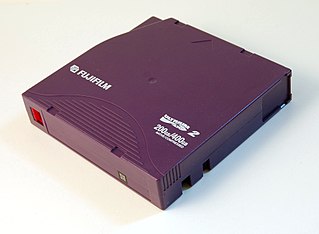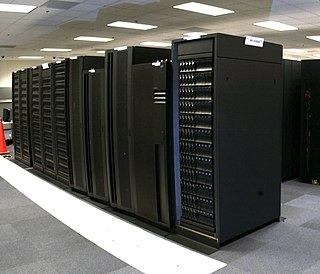
A tape drive is a data storage device that reads and writes data on a magnetic tape. Magnetic-tape data storage is typically used for offline, archival data storage. Tape media generally has a favorable unit cost and a long archival stability.

Digital Data Storage (DDS) is a computer data storage technology that is based upon the Digital Audio Tape (DAT) format that was developed during the 1980s. DDS is primarily intended for use as off-line storage, especially for generating backup copies of working data.

Advanced Intelligent Tape (AIT) is a discontinued high-speed, high-capacity magnetic tape data storage format developed and controlled by Sony. It competed mainly against the DLT, LTO, DAT/DDS, and VXA formats. AIT uses a cassette similar to Video8. Super AIT (SAIT) is a higher capacity variant using wider tape in a larger, single-spool cartridge. Both AIT and SAIT use the helical scan method of reading and writing the tape.

Linear Tape-Open (LTO) is a magnetic tape data storage technology originally developed in the late 1990s as an open standards alternative to the proprietary magnetic tape formats that were available at the time. Hewlett Packard Enterprise, IBM, and Quantum control the LTO Consortium, which directs development and manages licensing and certification of media and mechanism manufacturers.

Travan is an 8 mm magnetic tape cartridge design developed by the 3M company, used for the storage of data in computer backups and mass storage. Over time, subsequent versions of Travan cartridges and drives have been developed that provide greater data capacity, while retaining the standard 8 mm width and 750' length. Travan is standardized under the QIC body. HP Colorado, Iomega DittoMax and AIWA Bolt are proprietary versions of the Travan format.

The 8 mm backup format is a discontinued magnetic tape data storage format used in computer systems, pioneered by Exabyte Corporation. It is also known as Data8, often abbreviated to D8 and is written as D-Eight on some Sony branded media. Such systems can back up up to 60 GB of data depending on configuration. The cassettes have the same dimensions and construction as the cassettes used in 8 mm video format recorders and camcorders.
The 3480 tape format is a magnetic tape data storage format developed by IBM. The tape is one-half inch (13 mm) wide and is packaged in a 4 in × 5 in × 1 in cartridge. The cartridge contains a single reel; the takeup reel is inside the tape drive.

DVD recordable and DVD rewritable are optical disc recording technologies. Both terms describe DVD optical discs that can be written to by a DVD recorder, whereas only 'rewritable' discs are able to erase and rewrite data. Data is written ('burned') to the disc by a laser, rather than the data being 'pressed' onto the disc during manufacture, like a DVD-ROM. Pressing is used in mass production, primarily for the distribution of home video.

VXA is a tape backup format originally created by Ecrix and now owned by Tandberg Data. After the merger between Ecrix and Exabyte on 17 November 2001, VXA was produced by Exabyte Corporation. On November 20, 2006, Exabyte was purchased by Tandberg Data that has since stopped further development of the format.
Storage Technology Corporation created several magnetic tape data storage formats. These are commonly used with large computer systems, typically in conjunction with a robotic tape library. The most recent format is the T10000. StorageTek primarily competed with IBM in this market, and continued to do so after its acquisition by Sun Microsystems in 2005 and as part of the Sun Microsystems acquisition by Oracle in 2009.

Digital Tape Format is a magnetic tape data storage format developed by Sony. It uses a 1/2" wide tape, in a cassette with two reels, which is written and read with a helical scan process. The format is described by the ECMA 248 and ISO/IEC 15731 standards. There are two sizes of tape cassettes, "S" and "L".
Magnetic-tape data storage is a system for storing digital information on magnetic tape using digital recording.

The IBM Storage product portfolio includes disk, flash, tape, NAS storage products, storage software and services. IBM's approach is to focus on data management.
Qualstar Corporation is an American manufacturer of magnetic tape data storage products, based in Simi Valley, California. It was founded in 1984 as a 9-track tape drive manufacturer, and now makes tape library products. The company sold its last 9-track tape drive in 2006 and as of March 2006 has sold all remaining parts inventory to Vinastar, an aftermarket vendor.

The IBM 3590 is a series of tape drives and corresponding magnetic tape data storage media formats developed by IBM. The first drive, having the IBM product number 3590, was introduced in 1995 under the nickname Magstar. The 3590 series of tape drives and media are not compatible with the IBM 3592 line of drives that replaced it. They can store up to 60 GB of data (uncompressed). This family superseded the IBM 3480 Family of tape drives popular in 1980s and 1990s.
The IBM 3570 is a series of tape drives and corresponding magnetic tape data storage media formats developed by IBM. The storage technology and media were introduced using the name Magstar MP, combining the IBM storage brand name Magstar with MP for MultiPurpose. The IBM product number 3570 was associated with the tape drives and libraries that used the Magstar MP media.
Tape labels are identifiers given to volumes of magnetic tape.
The Linear Tape File System (LTFS) is a file system that allows files stored on magnetic tape to be accessed in a similar fashion to those on disk or removable flash drives. It requires both a specific format of data on the tape media and software to provide a file system interface to the data.















